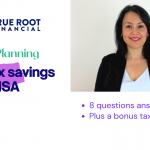Tax planning ideas to implement before year-end
Roshani Pandey is a financial advisor and founder of True Root Financial. True Root Financial is located in San Francisco, CA and serves clients across the globe.
Tax planning is integral to successfully manage your personal finances. To that end, here are some time-sensitive year-end tax planning ideas to explore with your financial and tax advisor.
A quick refresher on taxes
We pay income taxes in tiers AKA tax brackets. For example, an individual who makes $40K of taxable income, pays a 10% tax on income of up to $9,875 and 12% on the remaining. The total tax the individual pays is the sum of taxes derived from each tax bracket. When the total tax is expressed as a percentage of the income, it is called the effective tax rate. In other words, this is your average tax rate. Marginal tax rate, on the other hand, is your highest tax tier or the rate at which the next dollar will be taxed. In this case, the marginal tax rate is 12%. For tax planning purposes, marginal tax rate is important because it determines where the next dollar should be allocated.
1. Are you on the threshold of a tax bracket?
- Consider the following important tax thresholds. If you are in these thresholds, consider strategies to defer income or accelerate deductions. Additionally, consider strategies to manage capital gains and losses to keep you in the lower tax bracket.
- The biggest jump in marginal rates occurs when you pass the taxable income of $163,300 ( $326,600 if filing jointly). After this point, your marginal rate jumps from 24% to 32%.
- If taxable income is above $441,450 ($496,600 if filing jointly), you pay long-term capital gains of 20%. Below this level, the rate is 15%.
- If your Modified Adjusted Gross Income (MAGI) is over $200,000 ($250,000 if filing jointly), you may be subject to the 3.8% Net Investment Income Tax.
2. Can you benefit from contributing to a pre-tax vehicle?
Contributing to a vehicle such as a 401K, IRA or Healthcare Savings account (HSA) reduces your taxable income. If you are on the threshold of a tax bracket as discussed above, consider contributing to these vehicles. It can considerably reduce your overall taxes.
3. Do you make charitable donations?
- One of the biggest changes to come from the 2018 Tax Cuts and Jobs Act was the near doubling of standard deductions. As a result, most taxpayers found it more beneficial to claim standard deductions than to itemize deductions unless they had large itemized deductions, like a large charitable gift. If you plan to make charitable donations this year, consider bunching your charitable giving to a single year rather than spreading the gift and giving smaller amounts over the years. This way, you can take a large itemized deduction in the year you gift and still take advantage of the increased standard deductions in others. A vehicle such as a Donor Advised Fund allows you to commit to a charitable gift in one year and also get the charitable deduction. You can then spread the actual donations to charities over a number of years.
- Special considerations in 2020 due to CARES ACT: Taxpayers planning to itemize deductions can now claim increased deductions for charitable donations of up to 100% of their adjusted gross income. This was previously capped at 60%.
- Additionally, for taxpayers who claim standard deductions, the CARES Act allows you to deduct up to $300 in charitable donations. The only caveat is that the contributions need to be made to qualifying public charities, which include hospitals, schools, universities and qualified medical research organizations.
4. Do you own a business or are you self-employed? You may qualify for qualified business income deductions.
- If you own a pass-through business such as a sole proprietorship, LLC, S-corp or partnership, you may be eligible for qualified business income (QBI). The QBI is a tax deduction that allows eligible owners to deduct up to 20% of their qualified business income on their taxes. In general, total taxable income in 2020 must be under $163,300 for single filers or $326,600 for joint filers to qualify. You may still qualify even with income above these levels but the qualifications get more complicated. Consult with a qualified tax preparer to discuss these deductions.
- Consider the use of a Roth vs. traditional retirement plan and its potential impact on taxable income and Qualified Business Income
- If you have business expenses, consider if it makes sense to defer or accelerate the costs to reduce overall tax liability
- Some retirement plans, such as a Solo 401(k), must be opened before year-end.
5. Will you be receiving any significant windfalls that could impact your tax liability (inheritance, RSUs vesting, stock options, bonus)?
If so, review your tax withholdings to determine if you need to make estimated tax payments.
6. Do you expect your income to increase in the future?
Those that are young in their career can expect to see a bump-up in their salary in the future. Those that are taking a break from their career can also expect to see their income rise once they get back in the workforce. If you are one of these individuals, consider the following strategies to minimize your future tax liability: Make Roth IRA contributions and Roth conversions. Additionally, if offered by your employer, consider making Roth 401(k) contributions.
7. Do you expect your income to decrease in the future?
This includes most people who are in their prime earning years currently. If you are one of these individuals, consider strategies to minimize your tax liability now, such as by contributing to traditional IRA and traditional 401(k).
8. Have there been any changes to your marital status?
If so, consider how your tax liability may change based on your marital status as of December 31st.
If you would like to discuss any of these ideas one-on-one, please reach out to us here. Additionally, sign up for our newsletter below.









Leave a Reply
Want to join the discussion?Feel free to contribute!